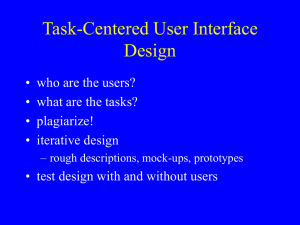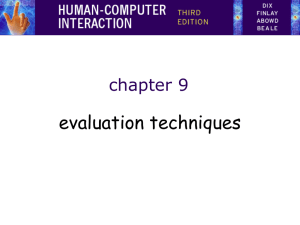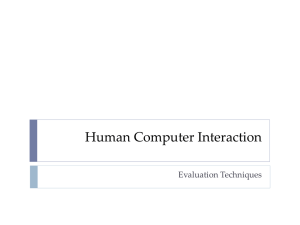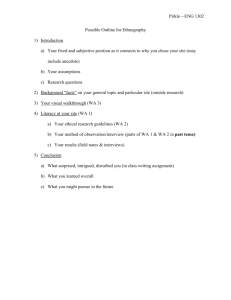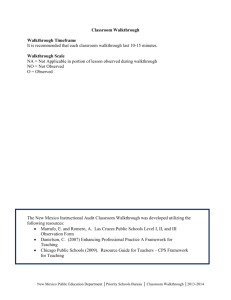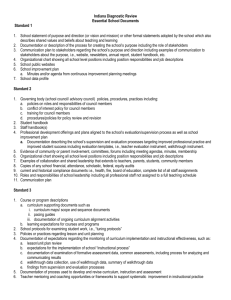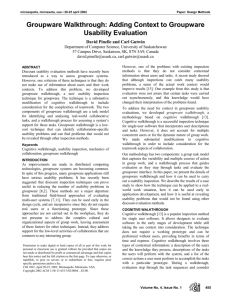Disadvantages of Cognitive Walkthrough
advertisement
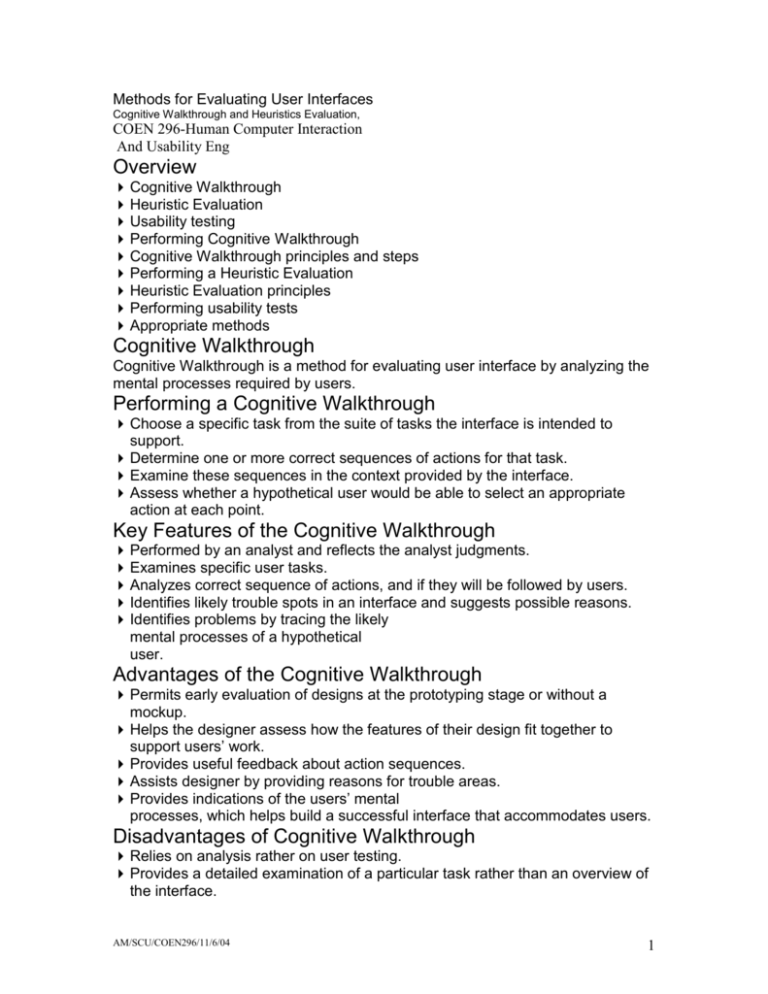
Methods for Evaluating User Interfaces Cognitive Walkthrough and Heuristics Evaluation, COEN 296-Human Computer Interaction And Usability Eng Overview Cognitive Walkthrough Heuristic Evaluation Usability testing Performing Cognitive Walkthrough Cognitive Walkthrough principles and steps Performing a Heuristic Evaluation Heuristic Evaluation principles Performing usability tests Appropriate methods Cognitive Walkthrough Cognitive Walkthrough is a method for evaluating user interface by analyzing the mental processes required by users. Performing a Cognitive Walkthrough Choose a specific task from the suite of tasks the interface is intended to support. Determine one or more correct sequences of actions for that task. Examine these sequences in the context provided by the interface. Assess whether a hypothetical user would be able to select an appropriate action at each point. Key Features of the Cognitive Walkthrough Performed by an analyst and reflects the analyst judgments. Examines specific user tasks. Analyzes correct sequence of actions, and if they will be followed by users. Identifies likely trouble spots in an interface and suggests possible reasons. Identifies problems by tracing the likely mental processes of a hypothetical user. Advantages of the Cognitive Walkthrough Permits early evaluation of designs at the prototyping stage or without a mockup. Helps the designer assess how the features of their design fit together to support users’ work. Provides useful feedback about action sequences. Assists designer by providing reasons for trouble areas. Provides indications of the users’ mental processes, which helps build a successful interface that accommodates users. Disadvantages of Cognitive Walkthrough Relies on analysis rather on user testing. Provides a detailed examination of a particular task rather than an overview of the interface. AM/SCU/COEN296/11/6/04 1 Provides no quantitative data. Main Steps for a Cognitive Walkthrough Preparation Analysis Follow up Cognitive Walkthrough Preparation Define assumed user background General knowledge Computer knowledge Task knowledge Choose a sample task Important Realistic Specify the correct action sequence(s) for the task Determine the interface state along the sequence(s) Cognitive Walkthrough Analysis For each action answer the following questions: Will the user be trying to achieve the right effect? Will the user notice the correct action is available? Will the user associate the correct action with the desired effect? If the correct action is performed, will the user see that progress is being made? Based on the “yes” or “no” answer: Explain why a user would choose that action Explain why a user would not choose that action Cognitive Walkthrough Follow-up Suggest where the design is likely to fail and why. Provide specific guidance for each problem. Indicate which the problems may be superficial and where profound changes are needed. Report the designer’s view of the interface and eventual difference with the users’ view (if any). Heuristic Evaluation A systematic inspection of a user interface design by interface specialists to determine the usability, based on their experience, guidelines, and standards. Advantages of a Heuristic Evaluation Relatively inexpensive and fast Performed at any phase of product development Identifies many problems Achieves substantially better performance by aggregating the evaluation from several evaluators Provides an overview of the complete design Pays direct attention to particular aspects of a design and associated problems AM/SCU/COEN296/11/6/04 2 Does not attempt to trace specific user behavior, rather it critiques the attribute of an interface itself Disadvantages of a Heuristic Evaluation Relies on analysis rather on user testing Relies on the judgment of the evaluator and his/her level of expertise Performing a Heuristic Evaluation Use multiple evaluators for the best results. A single evaluator will miss most of the usability problems in an interface. Each evaluator should inspect the interface on their own. An evaluation session generally lasts one or two hours. Longer sessions are needed for more complicated systems. Evaluators individually decide how they want to proceed with evaluating the interface. Each evaluator provides a report or recorded version. Heuristic Evaluation Principles Feedback or visibility of system status Use of users' language User control and freedom Consistency and standards Error prevention and error messages Recognition rather than recall Flexibility and efficiency of use Aesthetic and minimalist design Help and documentation Feedback The system should always keep users informed about what is going on through appropriate feedback within reasonable time. System feedback should be expressed in the users’ language to guide and provide effective feedback. Feedback must be provided in case of system failure. Using the Users' Language Use users’ language rather than system-oriented terminology. Use users’ language in selecting icons and nonverbal elements in the interface. Do not use words contrary to the definition understood by the general population or community of users. View interaction from the users’ perspective. User Control and Freedom Provide users with an emergency exit. Support redo and undo(s). AM/SCU/COEN296/11/6/04 3 Consistency and Standards Create and follow a standard when designing an interface User Experience Standards Guide The same information should be presented in the same location on all screens and dialogue boxes The task and functionality structure must be consistent throughout the product Error Prevention and Error Messages Error prevention Avoid the error situation in the first place. An error with serious consequences must be eliminated through design improvement. Error messages Written clearly Precise rather than vague Helps the user solve the problem Polite and not intimidating or blaming to the user Recognition Rather than Recall Allow users to choose from items generated by the computer. Display as many objects as needed to the users. Supply information as part of the dialogue. Use a small number of rules that apply throughout the user interface to reduce the learning/remembering load. Use generic commands as much as possible to support the transfer of learning from one application to the next. Flexibility and Efficiency of Use Novice, expert, occasional, and frequent users interact with the system in different ways. You should allow users to: Customize their frequent actions Customize their interface preferences Provide short cuts and frequently used options such as “favorites” Aesthetic and Minimalist Design Follow the “less is more” rule for information content of screens and the choices of features. Providing a lot of information can confuse the novice users and slow down the expert users. Provide only the information that is really important to users in performing their tasks. Help and Documentation Create systems that do not need help or documentation in order to operate AM/SCU/COEN296/11/6/04 4 them. If help or documentation is needed: Provide a search feature to allow the user to find information. Write the information in the language of the user, corresponding to the tasks users want to perform. Provide instruction regarding application of the instructions. Questions Conclusion AM/SCU/COEN296/11/6/04 5
